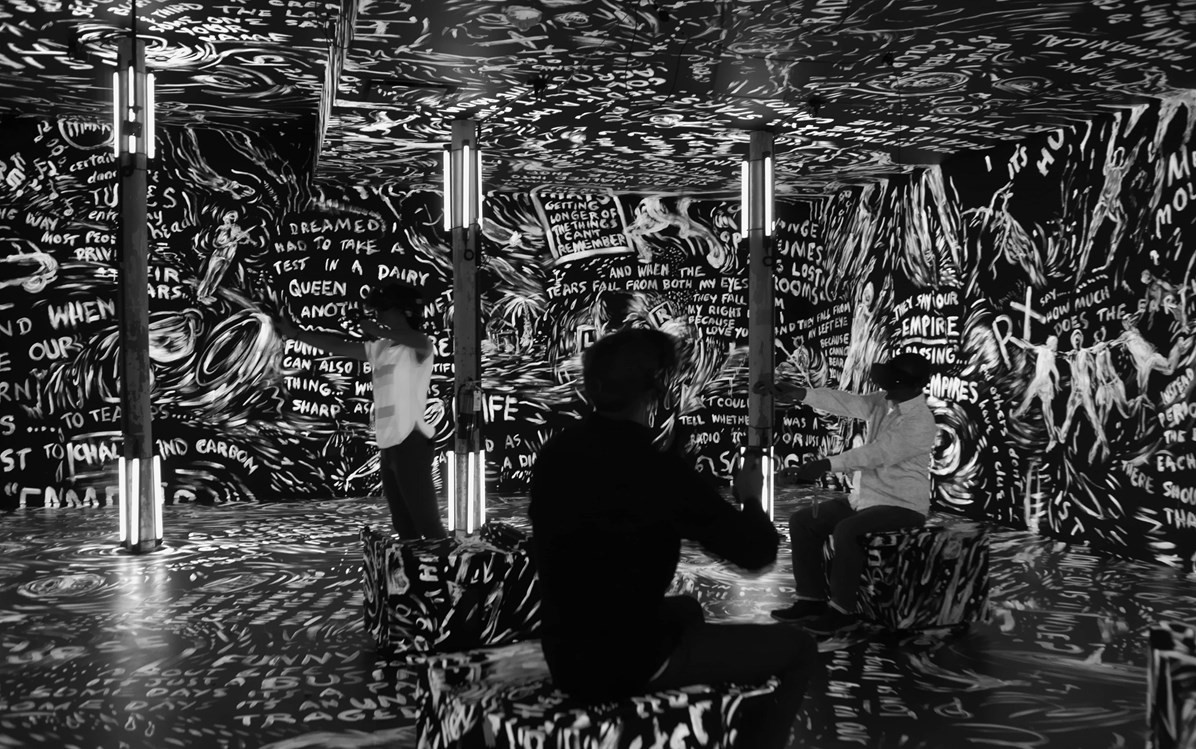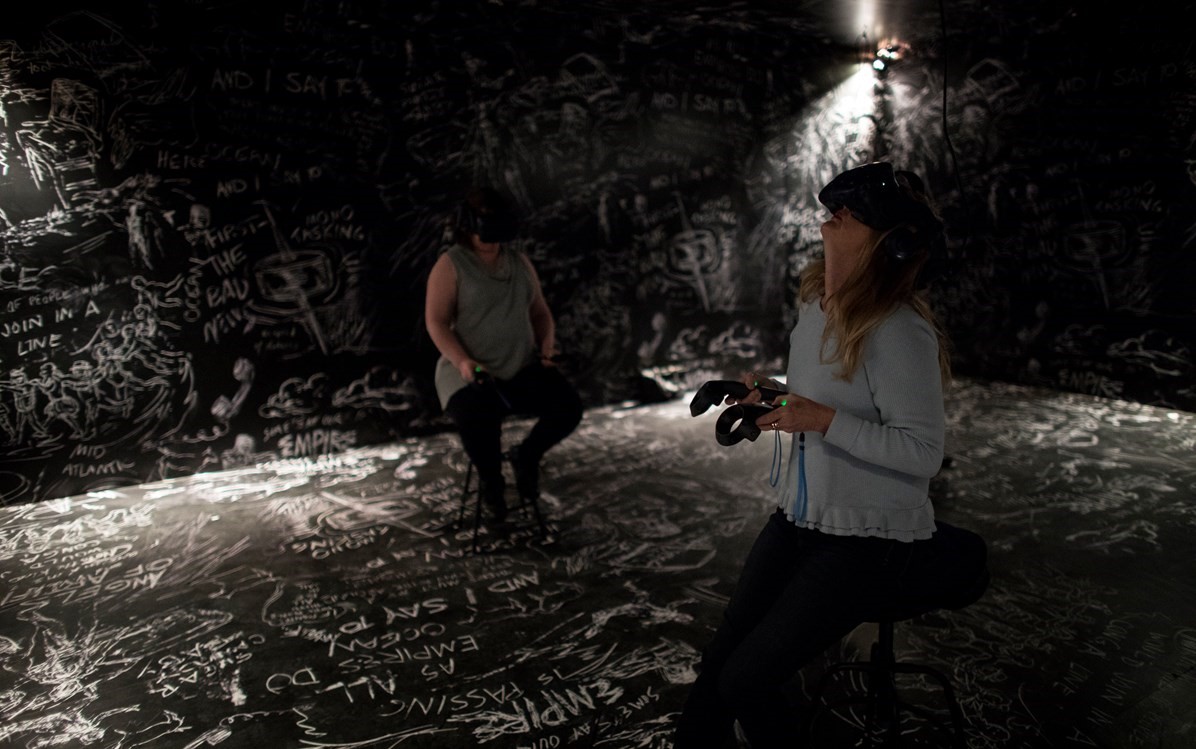
Art and Virtual Reality: A Beginner's Guide
New ways of being 'in conversation' with a world outside of our own context are dawning, in particular, thanks to the world of technology. For the first time, our Visual Arts program has dabbled in the world of virtual reality with two stunning exhibitions.
From legendary artist/director Lynette Wallworth and the Amazonian Yawanawa people comes Awavena, a stunning tale of metamorphosis, and the second in a series of mixed-reality works by Wallworth and producer Nicole Newnham, following their Emmy-winning Virtual Reality film Collisions.
Created by pioneering artist and musician Laurie Anderson and Taiwanese new media artist Hsin-Chien Huang, Chalkroom is a VR work unlike any other. Instead of the brightly-lit gaming world of most VR, everything is hand drawn, dusty and dark, creating a shadowy, atmospheric world to explore.
The following observations are by Sam Beard, a member of the inaugural Visual Arts Writing Group.
Awavena is on until 22 March at Art Gallery of Western Australia.
Chalkroom is on until 19 April at Perth Institute of Contemporary Arts.

Laurie Anderson & Hsin-Chien Huang. Chalkroom, 2017, flourescent paint on slate walls. Courtesy the Artists
OBSERVATIONS BY SAM BEARD
Virtual reality is dreamlike. With the headset fastened, my eyes and ears respond to experiences that the rest of my body felt detached from. It’s a disembodying feeling. Although I’ve scrapped my Tron-tainted assumptions of VR tech, I am definitely a beginner, and maybe you are too. So, from one beginner to another, here is a quick guide to help traverse the surreal and immersive sensory experiences to be had at Perth Festival.
These virtual experiences are opportunities to learn and discover, something Australian artist and filmmaker Lynette Wallworth knows very well.
Showing at the Art Gallery of Western Australia for Perth Festival 2020, Awavena (2018) is Wallworth’s latest project and is the result of years of work and collaboration between the Yawanawá people from southwest of the Brazilian Amazon. Introducing us to Hushahu, the first woman shaman of the Amazonian Yawanawá people, this is a virtual journey into spiritual knowledge. A true story, Awavena is a mesmerising mix of cutting edge technologies and community collaboration, sharing experiences, culture and knowledge. The Yawanawá’s powerful story is matched with Wallworth’s artistry.
Wallworth has worked with immersive technologies for years and has previously collaborated with Indigenous elder Nyarri Nyarri Morgan and the Martu people of central Western Australia on the award-winning VR film Collision (2016).

Image: Lynette Wallworth, Awavena, 2018, film still. Courtesy the artist
Embracing digital technologies, many contemporary artists are exploring the possibilities of VR technology. Significant examples include Marina Abramović’s Rising (2018), a virtual world that considers the emotional toll of climate change, and Jeremy Couillard’s surreal Alien After (2017), a first-person video game installation in which the player, after dying in hospital, finds that the afterlife is run by bizarre alien creatures. VR might seem daunting and futurist, but it has well and truly arrived in the art world. And in VR, unlike photography or film, you cannot turn away. There are no distractions, no mobile phone left on in the cinema, you are embedded.
Challenging new technology has been the basis for Laurie Anderson’s career. An American creative pioneer, Anderson has pushed the boundaries of sound (check out her classic album Big Science, 1982), art and even videogames. This included Interactive CD-ROM Puppet Motel (1995), an unusual mix of audio, video and ‘90s point-and-click gaming, where players are guided by a ventriloquist puppet Laurie Anderson lookalike through the motel. Not only was this among Anderson’s first attempts with virtual technology, it was also her first collaboration with Taiwanese new media artist Hsin-Chien Huang. They have since collaborated on numerous projects, including Chalkroom, presented around the world and now at Perth Institute of Contemporary Arts.
When you strap on your headset and enter the Chalkroom, you find a dusty world of drawings and words. Around you is darkness. You move through black corridors and hallways defined by words and scrawled markings in chalk, guided by Laurie Anderson’s voice. Words float by you, vanishing into the peripheral. These experiences expand the ways we think of language, mind and body. Virtual reality challenges the accustomed ways of experiencing art, and offers new ways of fulfilling what art often does best – encourage us to learn and discover, and understand the world and our place within it.
ABOUT SAM BEARD

Sam Beard, born in Busselton, is interested in the arts of Western Australia. He has tutored in visual art and literature, encouraging secondary school students to pursue tertiary education and the value of the arts in intellectual and social development. Currently studying the history of art at the University of Western Australia, he also organises marketing and assists with exhibitions at the Bunbury Regional Art Gallery. Beard has authored articles, essays and reviews for publication.